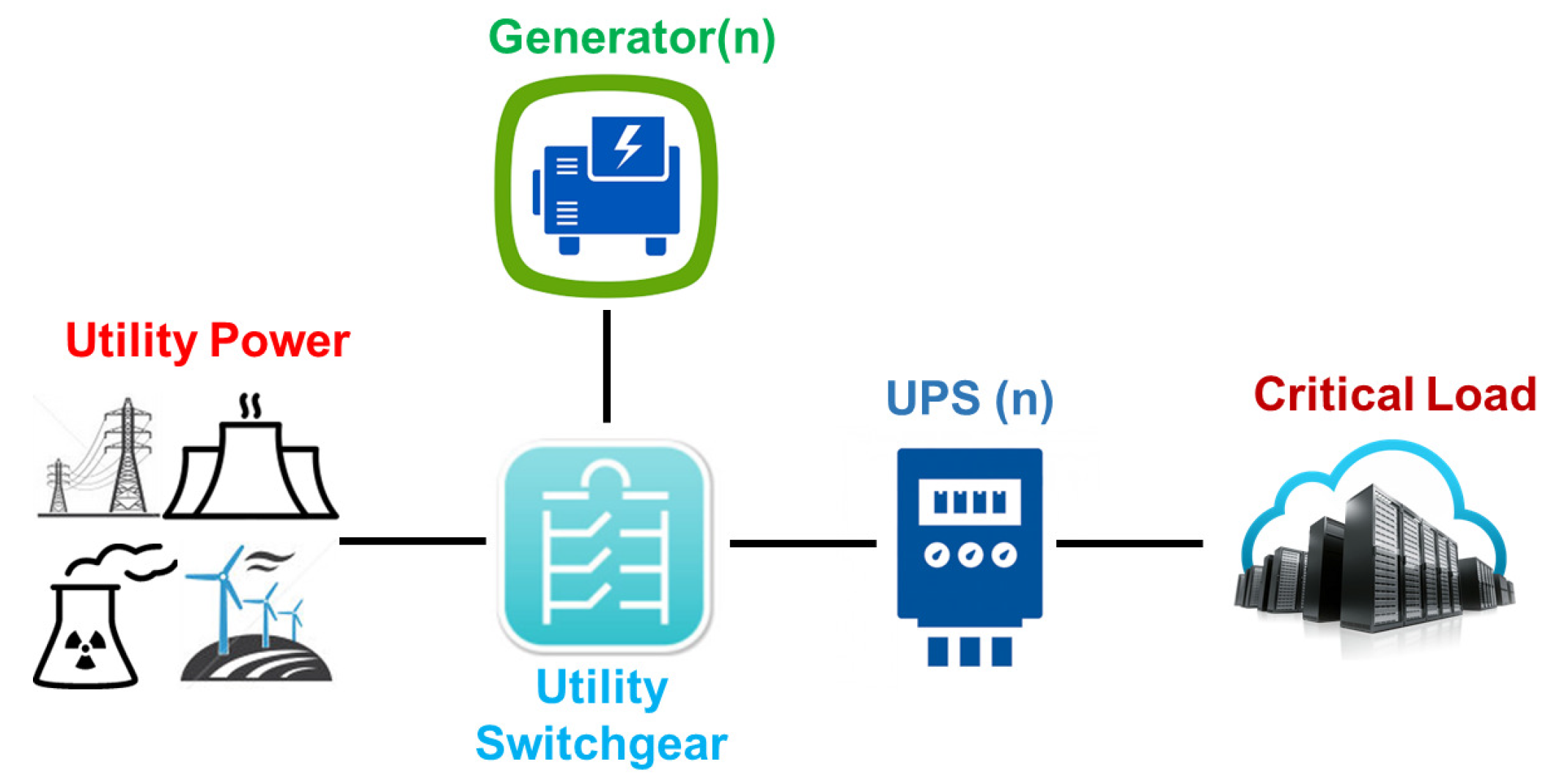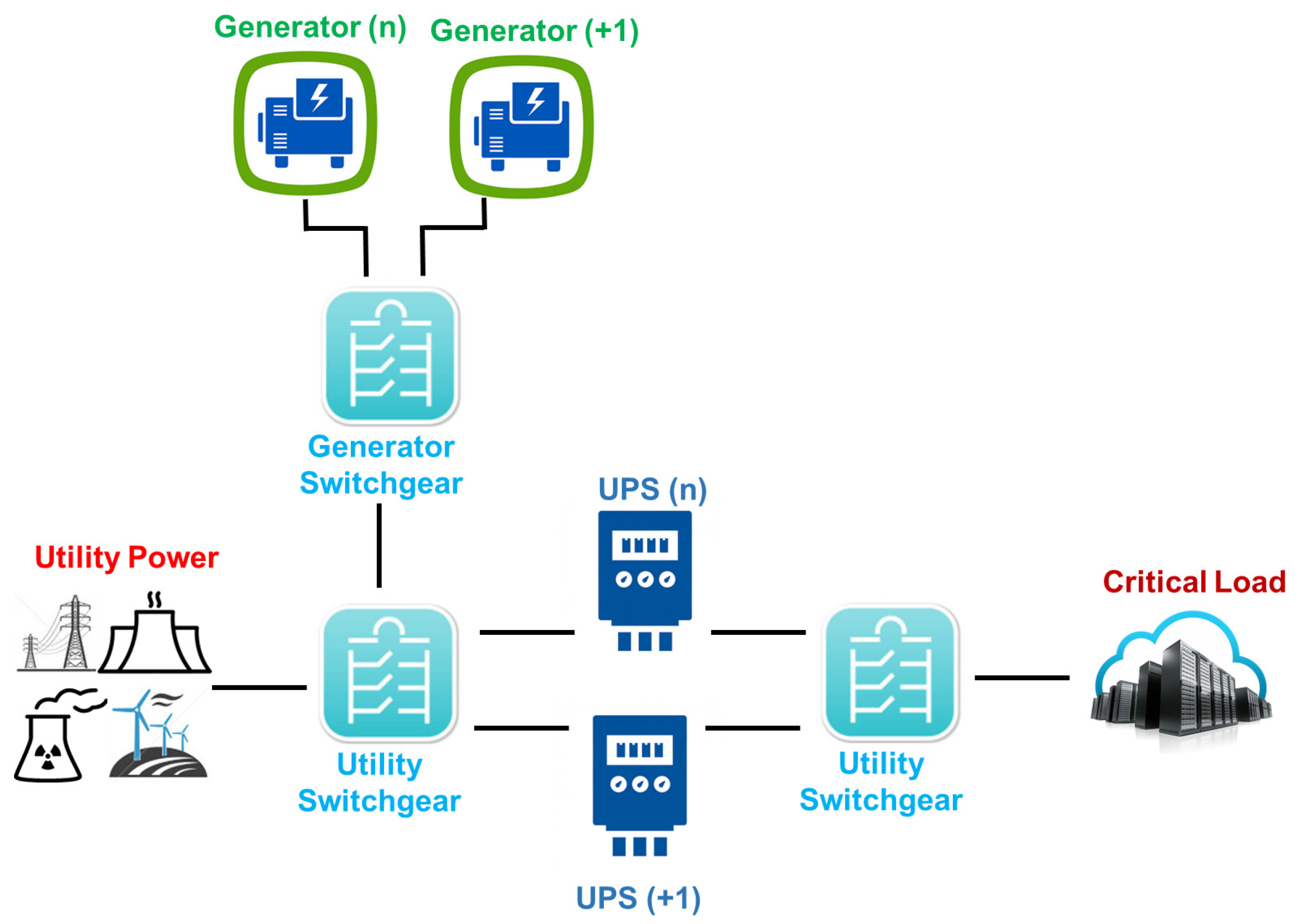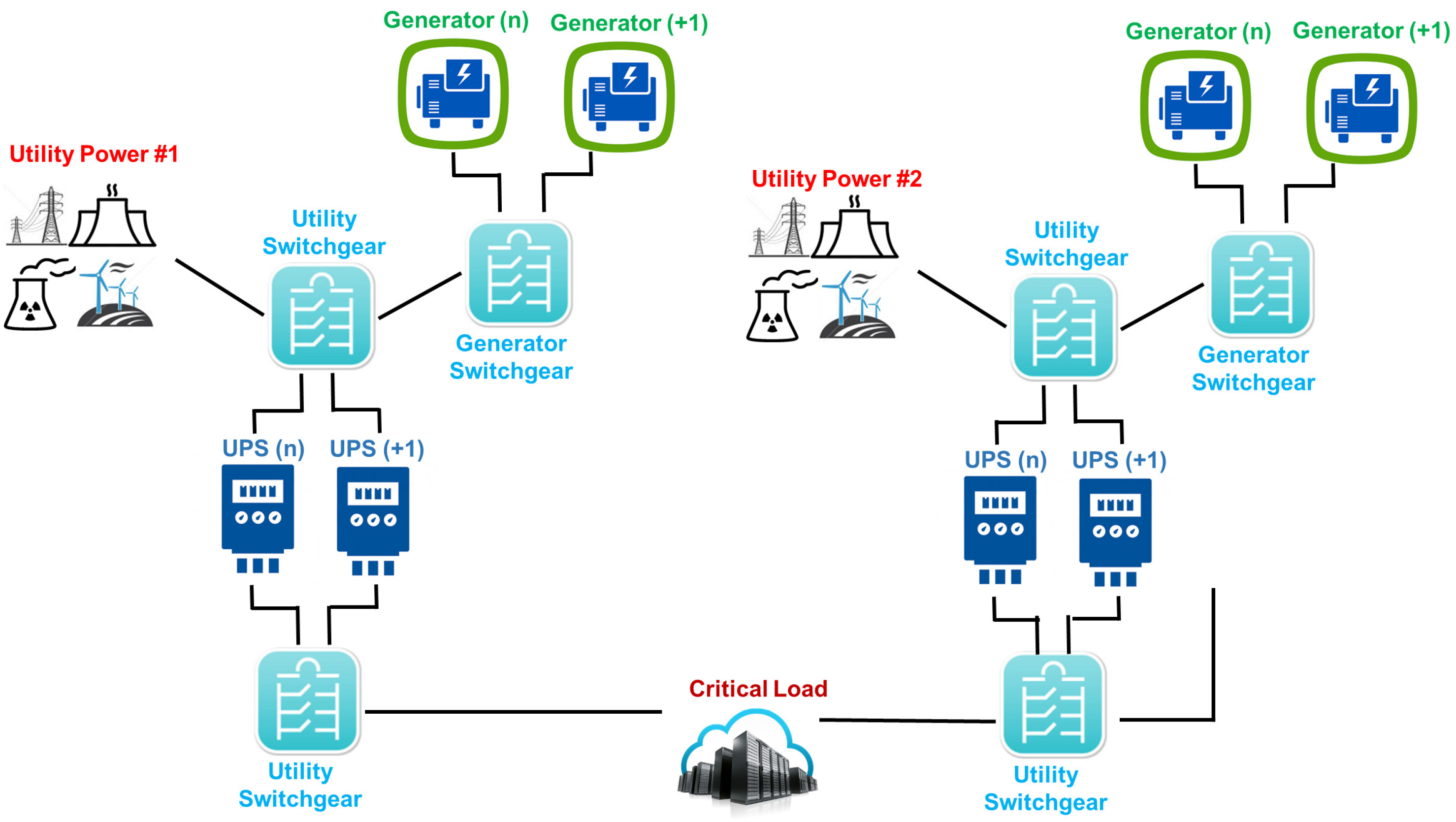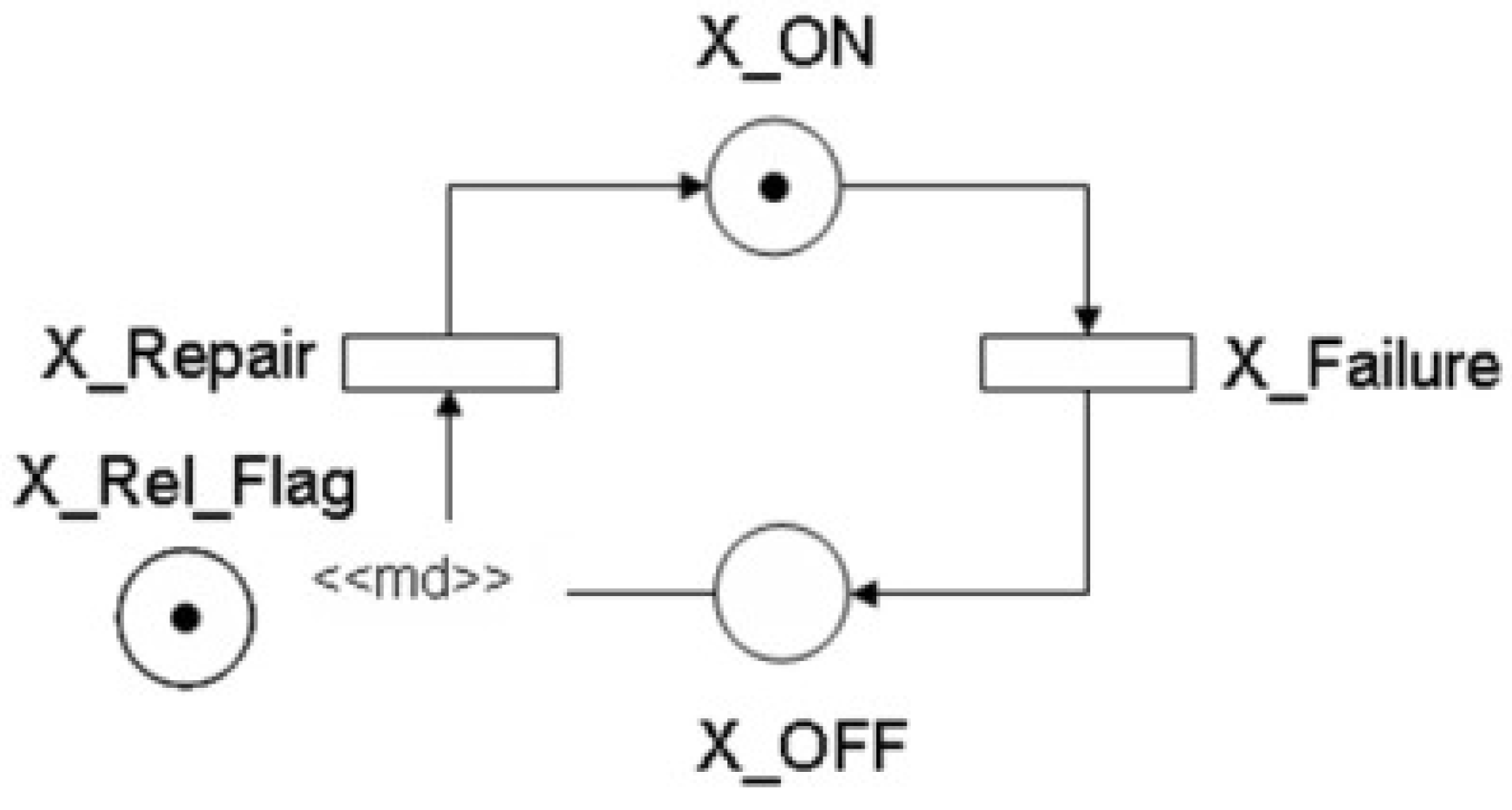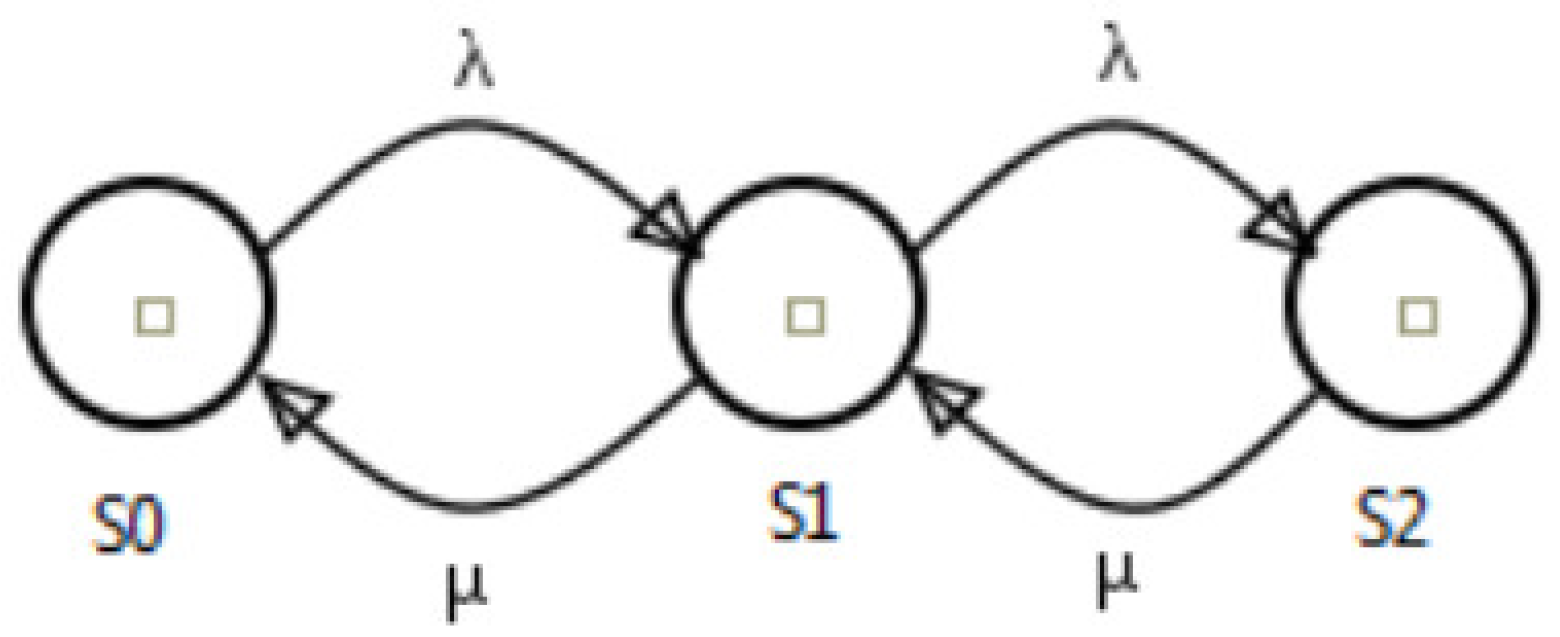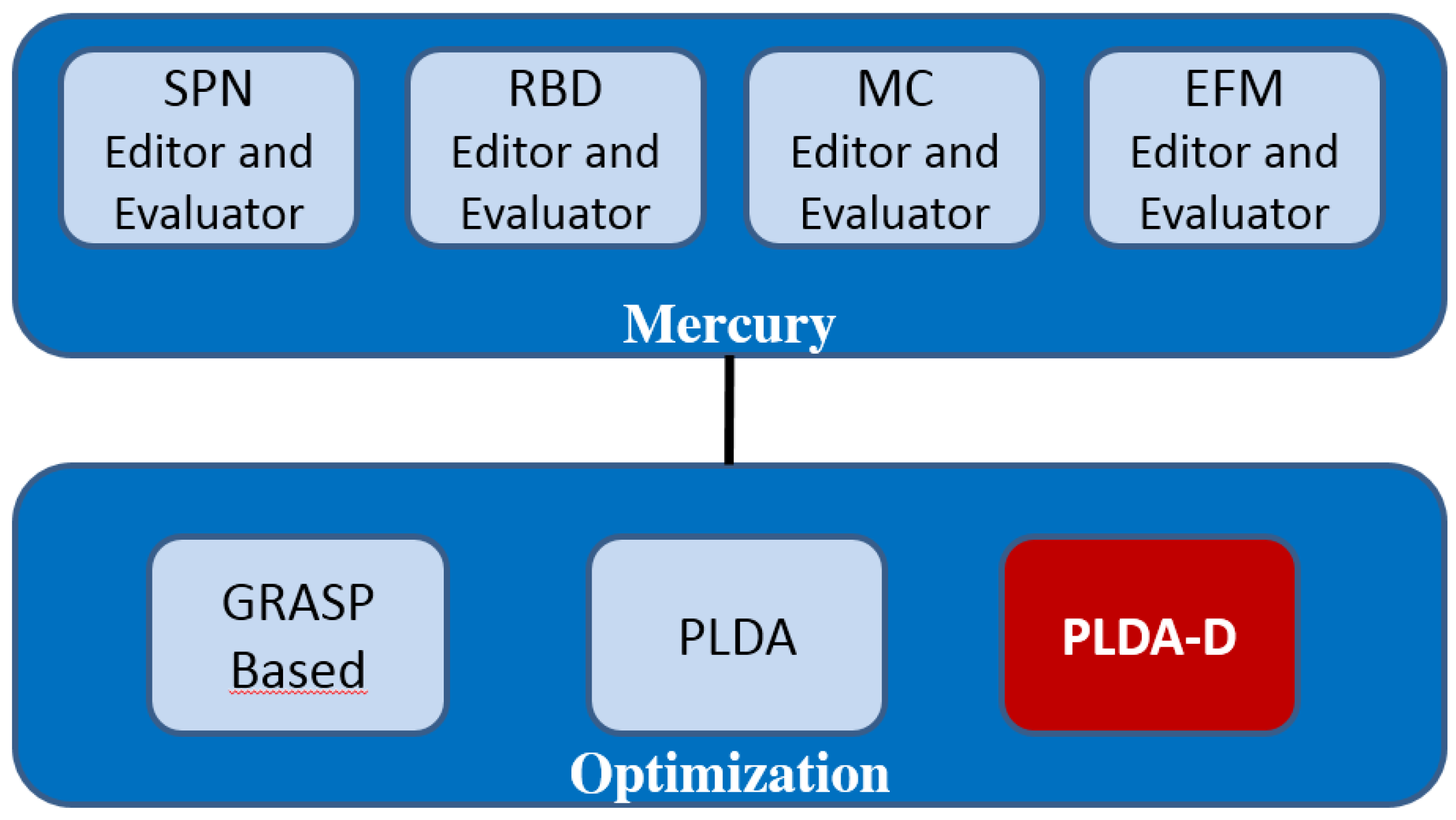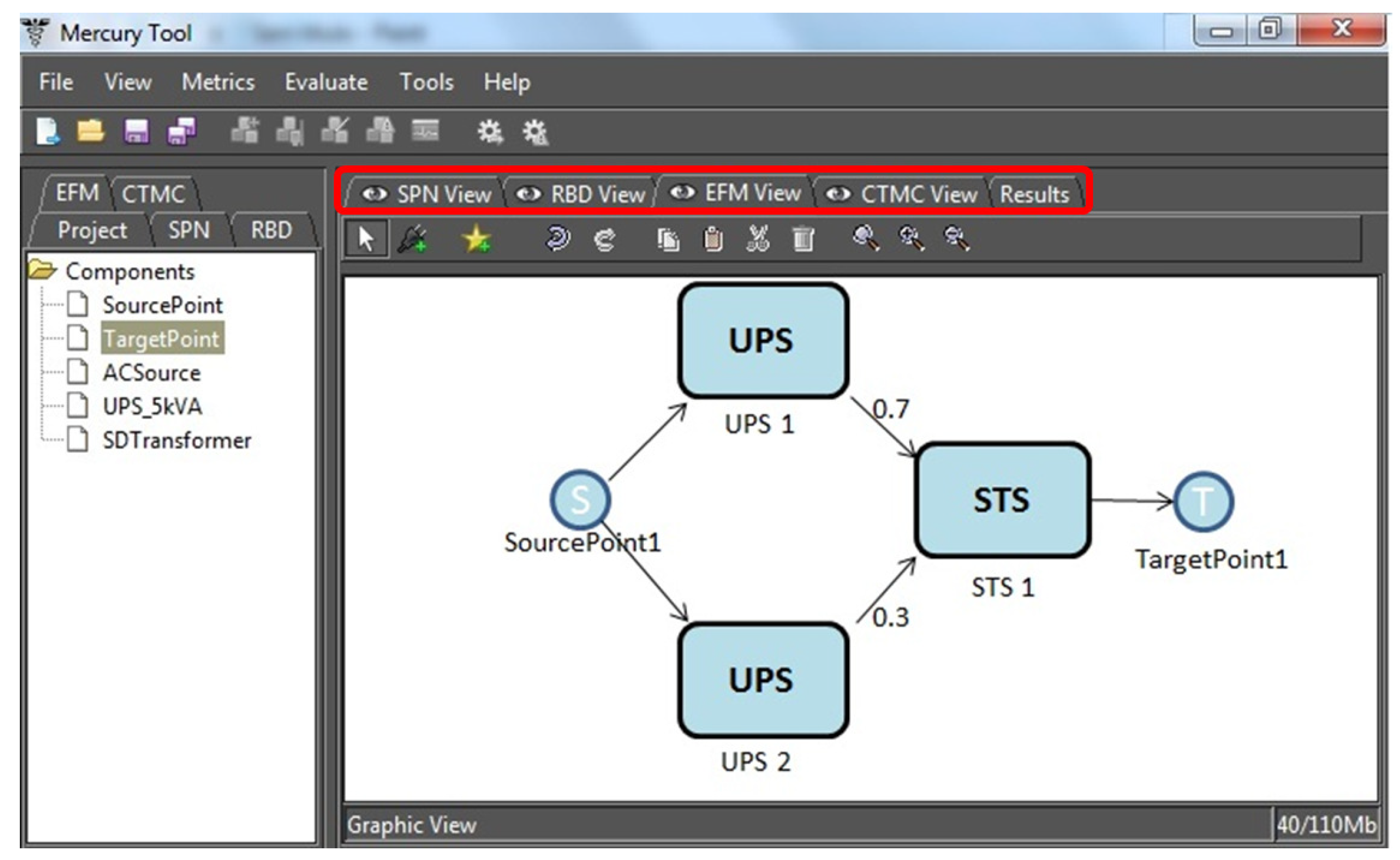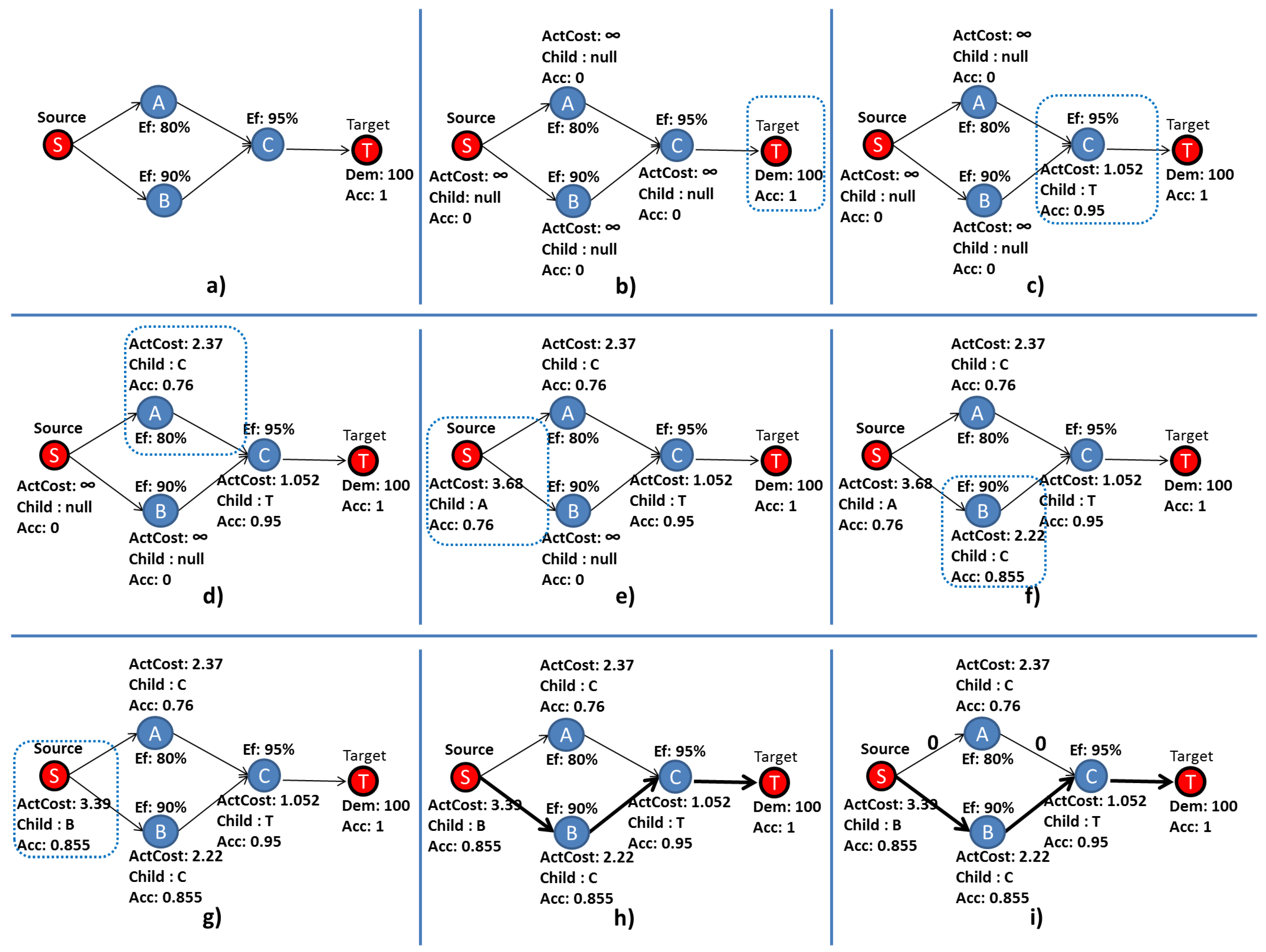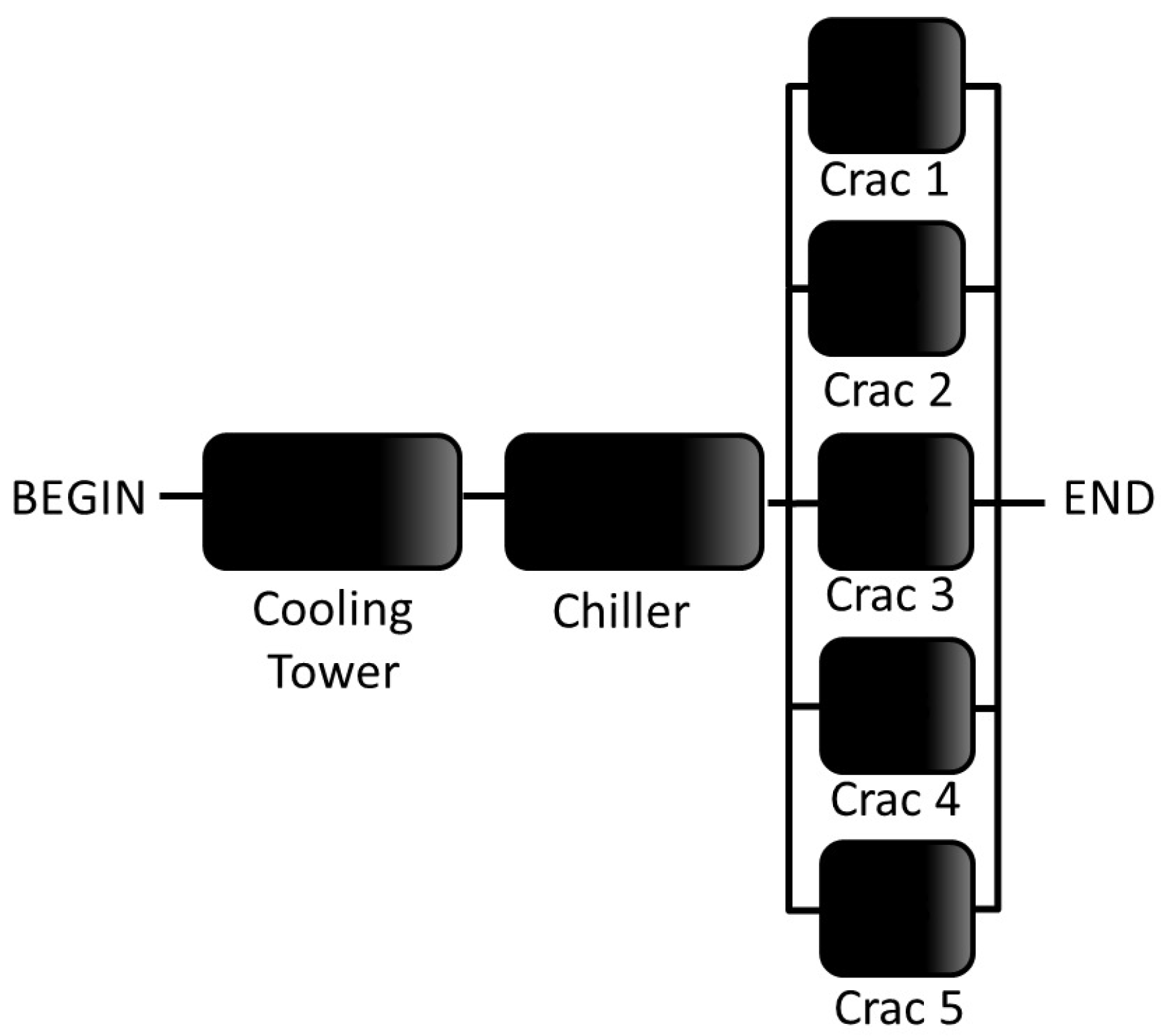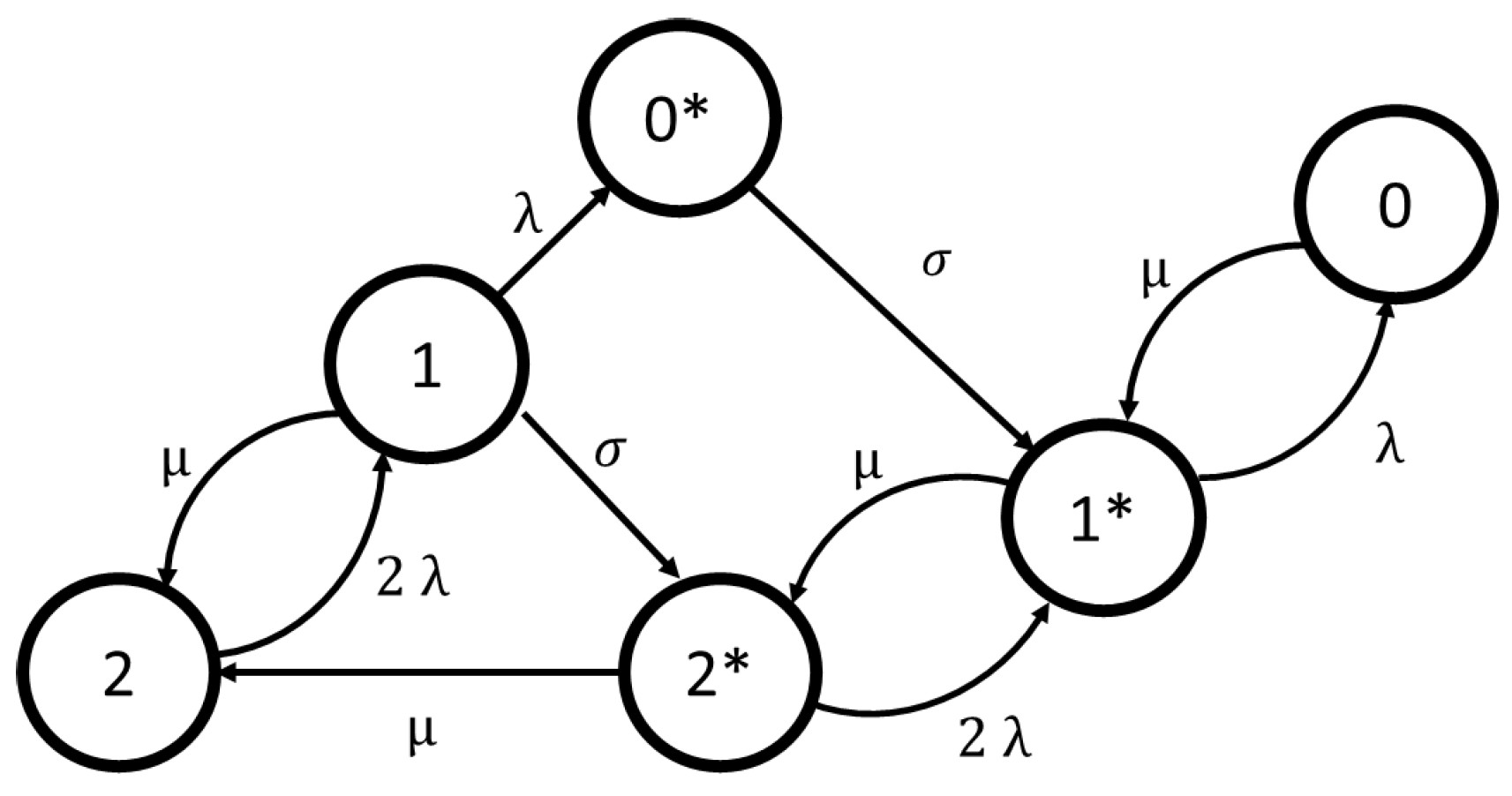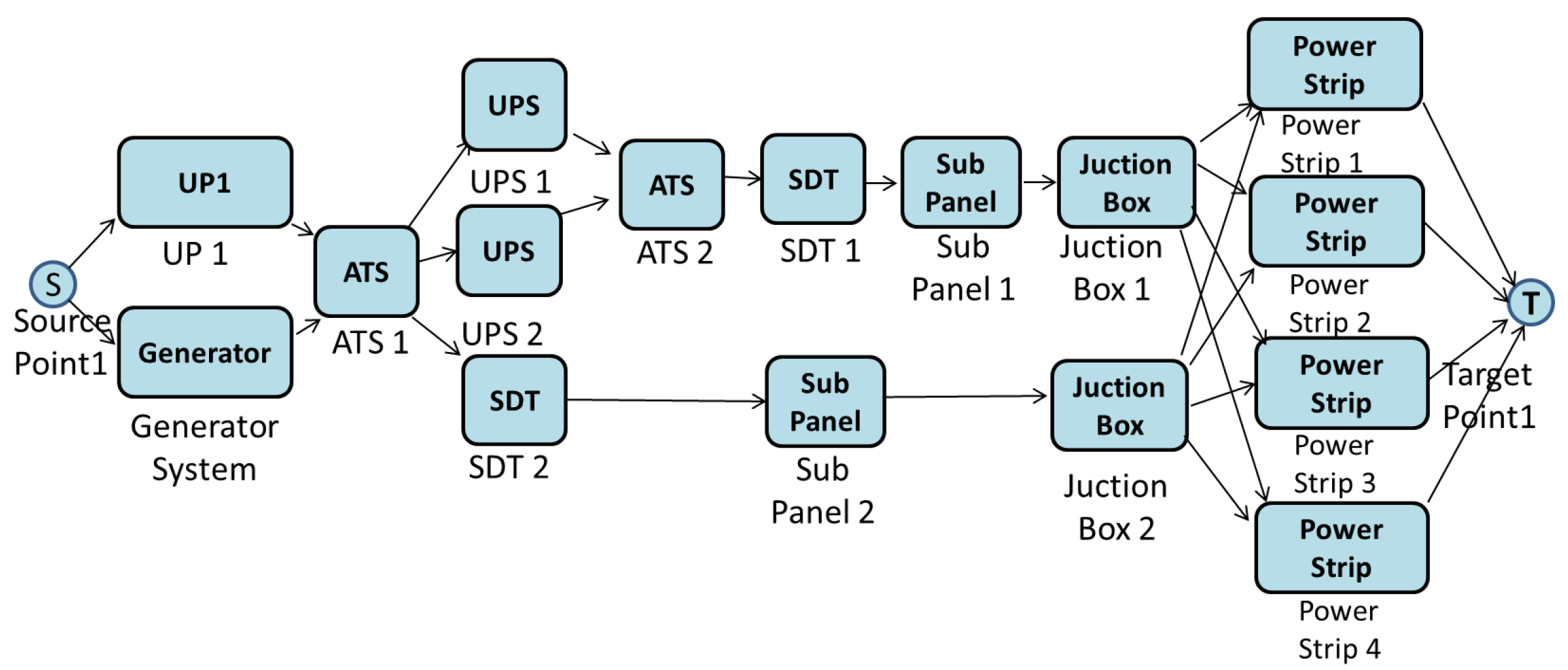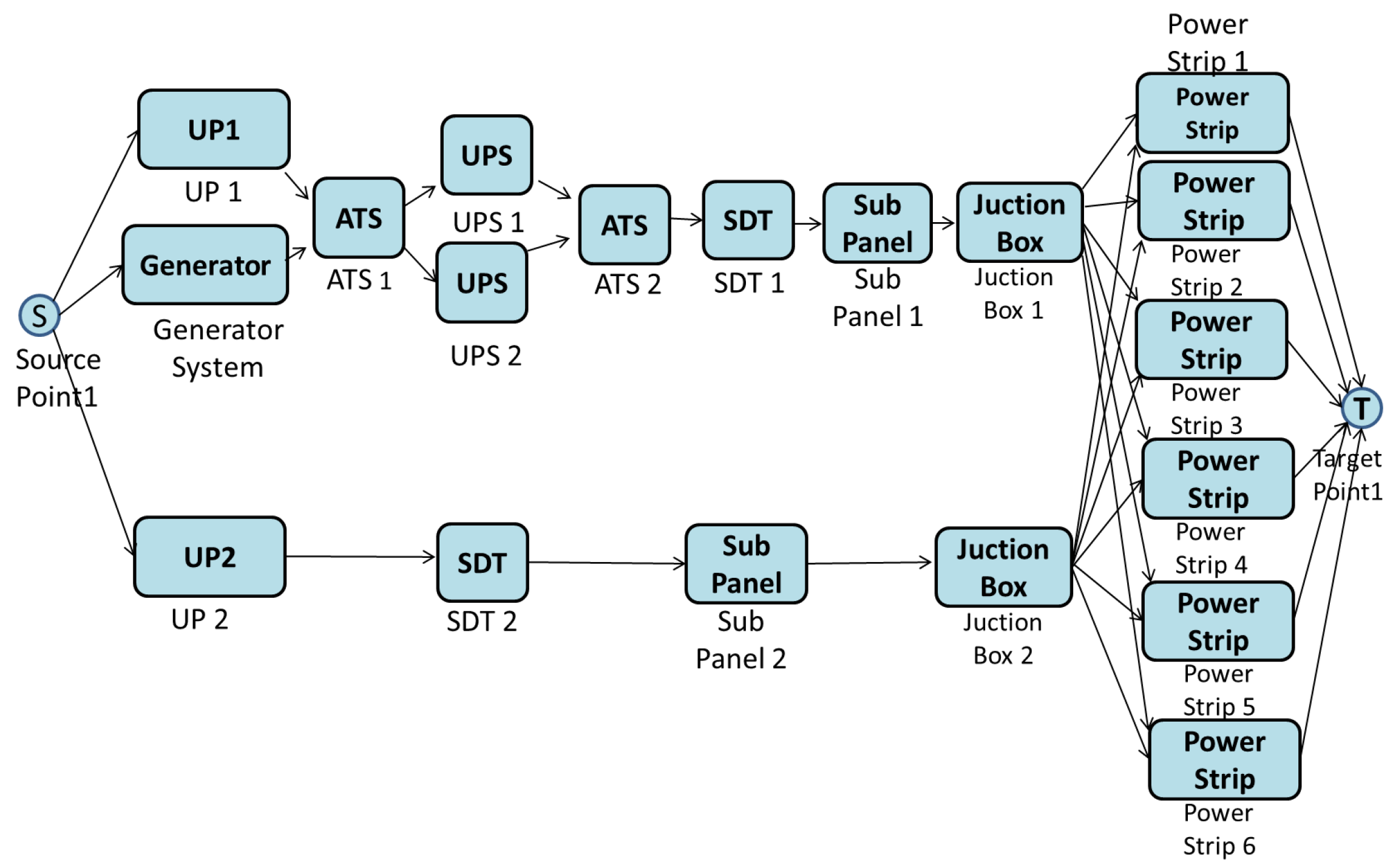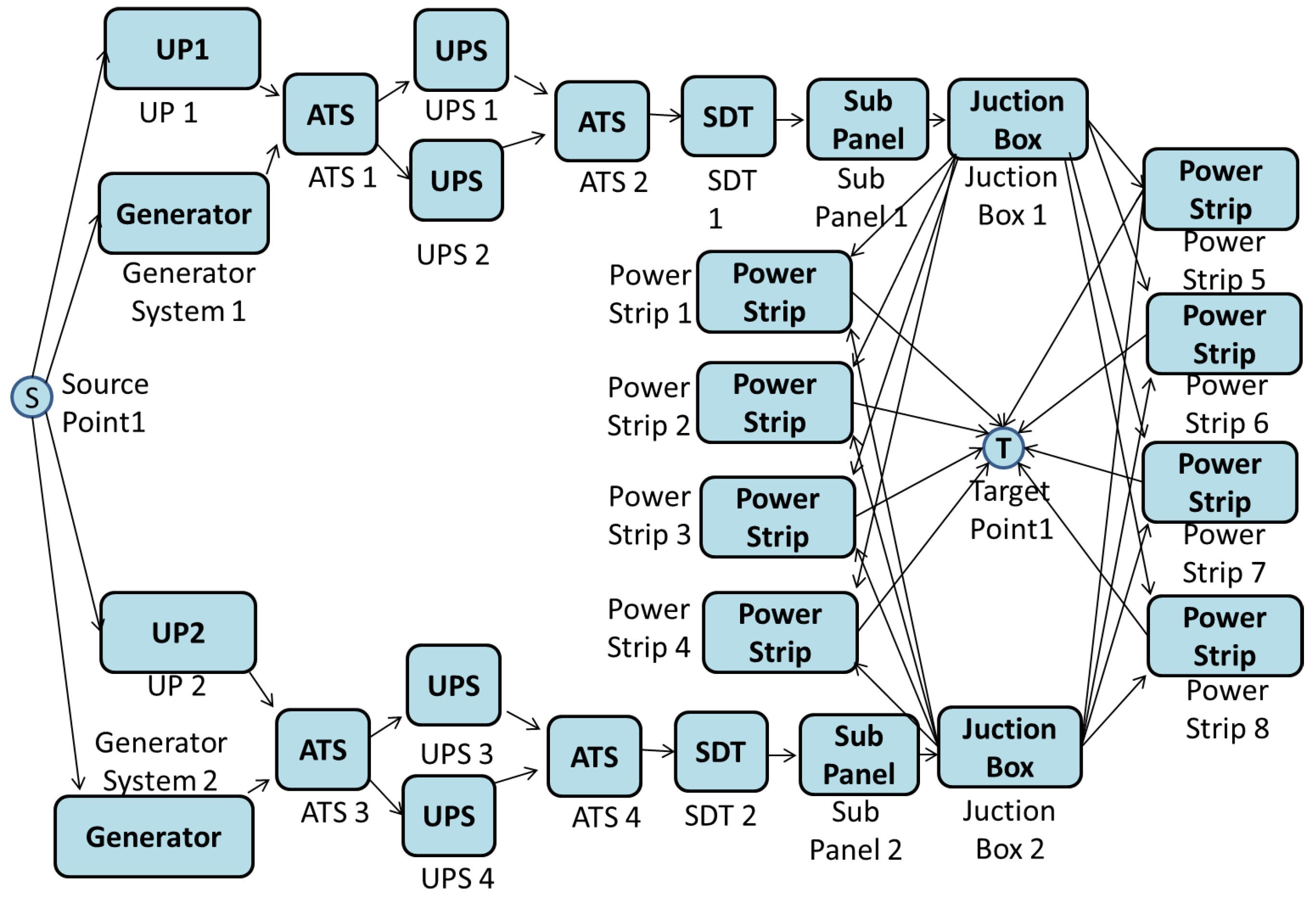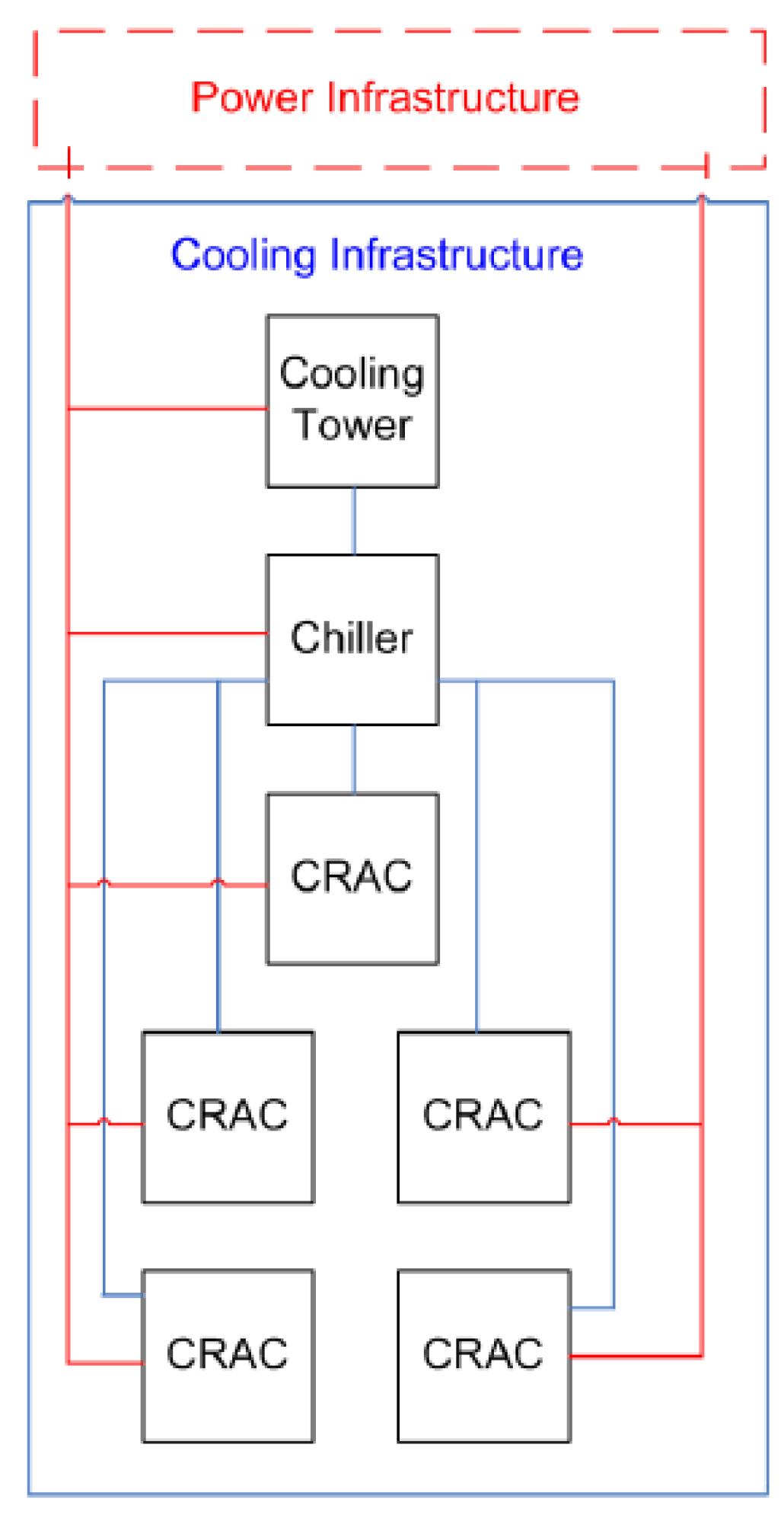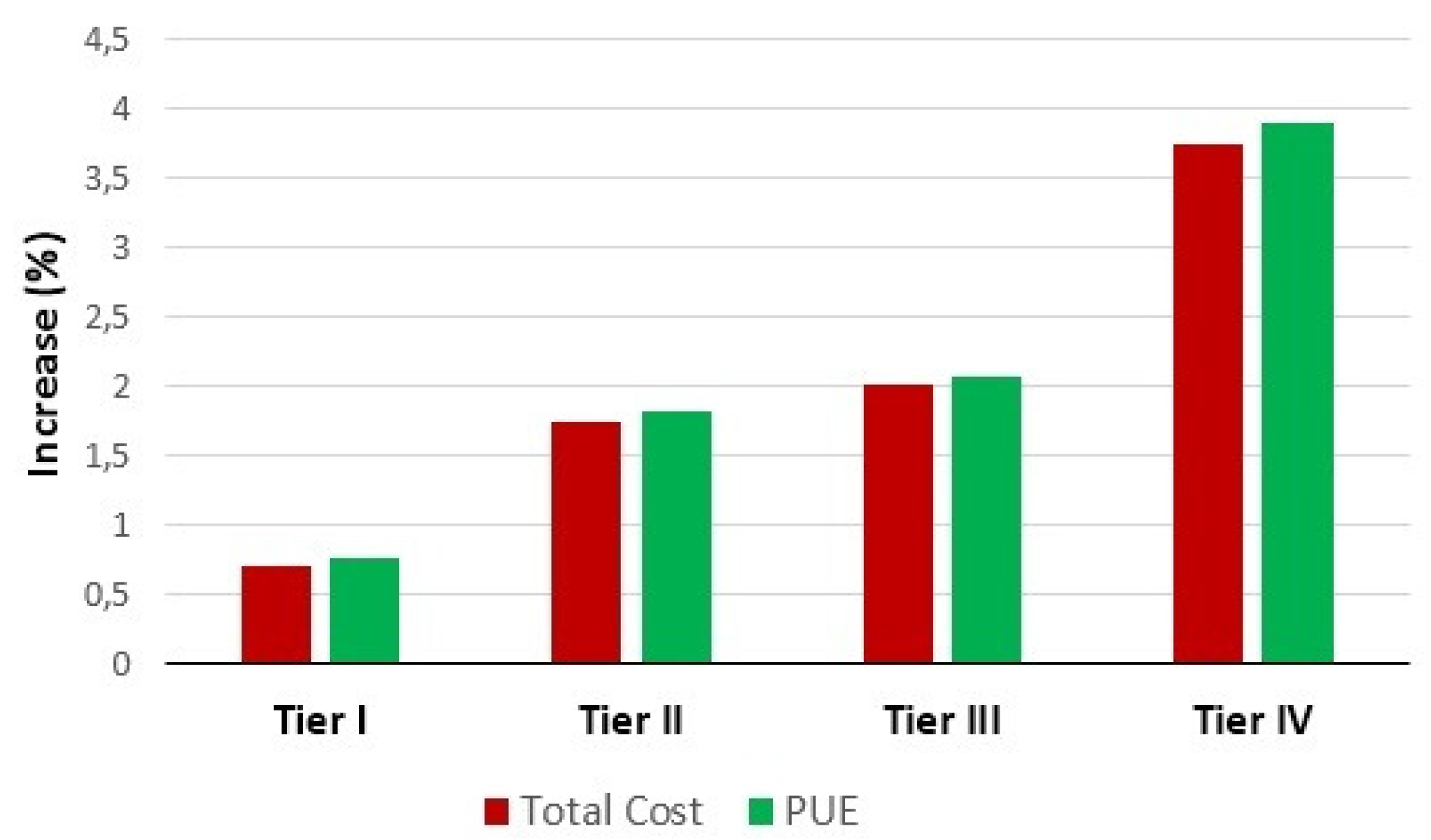1. Introduction
Social awareness has influenced the way the world works and how people live. Widely available Internet access, the growing mobile market and advances in cloud computing technology are generating a huge amount of data, thus entailing unprecedented demands on energy consumption. The digital universe corresponds to 500 billion gigabytes of data [
1], for which only 25% of the world’s population is on-line [
2].
Data center power consumption has increased significantly over recent years, influenced by the increasing demand for storage capacity and data processing [
3,
4,
5]. In 2013, data centers in the U.S. consumed 91 billion kilowatt-hours of electricity [
6], and this is expected to continue to rise. In addition, critical elements in the performance of daily tasks, such as social networks, e-commerce and data storage, also contribute to the rise in energy consumption across these systems.
Data center infrastructures require electrical components, many of which may directly affect system availability. Fault-tolerant mechanisms are key techniques for handling equipment with limited reliability. The Uptime Institute [
7] is an institution that classifies the infrastructure of the data center based on the architectures and characteristics of redundancy and fault tolerance (Tier I, Tier II, Tier III and Tier IV). In this paper, four data centers were analyzed, considering different tiers of architectures for the power subsystem. The power subsystem electrical flow is represented by the energy flow model (EFM) [
8].
The algorithm proposed in this paper, named power load distribution algorithm-depth (PLDA-D), improves the results presented in our previous work when considering the operational cost and energy efficiency of data centers [
8,
9,
10]. Now, we have obtained the shortest path, using Bellman algorithm instructions, considering the energy cost as the main metric and the maximum energy flow (Ford–Fulkerson), considering the energy efficiency of each component of the data center’s electrical infrastructure. Thus, we propose this new algorithm that uses two criteria of different classes that complement each other.
Both the proposed algorithm and the EFM model are supported in the Mercury modeling environment (see
Section 4). In addition to the EFM model and the proposed algorithm, the Mercury environment also supports reliability block diagrams (RBD) [
11], Markov chain [
12] and stochastic Petri nets (SPN) [
13] modeling, which are an essential part of the analysis. As such, the impact on the power subsystem reliability and availability was included.
The paper is organized as follows.
Section 2 presents studies related to this research field.
Section 3 introduces the basic concepts of the data center tier classification, sustainability and dependability.
Section 4 presents an overview of the Mercury evaluation platform.
Section 5 describes the energy flow model (EFM).
Section 6 explains the PLDA-D.
Section 7 describes the basic models adopted.
Section 8 presents a case study, and finally,
Section 9 concludes the paper and suggests directions for future work.
2. Related Works
Over the last few years, considerable research has been conducted into energy consumption in data centers. This section presents studies related to this research field.
Al-Fares [
14] proposed an engine, called Hedera, for dynamic re-routing of the traffic of networking switch topologies that compose data center infrastructures. The main goal is to optimize the network bandwidth utilization with the proposed scheduler engine that has a minimal overhead on the available flows. Following the proposed approach by the authors, the bandwidth utilization was optimized to over 113% in relation to the static load-balancing strategies.
Dzmitry [
15] proposed a methodology, named “Data center energy-efficient network-aware scheduling" (DENS) to manage job performance, energy consumption and data traffic. This proposed strategy is able to dynamically analyze the network feedback and make decisions to improve performance, energy consumption and the traffic. Therefore, the goal is to conduct the balance between those metrics, as well as to minimize the number of computing servers required on the data center that provide support to the services contracted.
These two papers are complementary to ours, as we propose a solution to reduce the energy consumption through the IT equipment of a data center, and those papers reduce the energy consumption by improving the network utilization.
Doria [
16] extended the PowerFarm software [
17] concept by adding an online monitor of loads and the correspondent power consumption. Additionally, the proposed EnergyFarm tool is able to turn off/on servers as needed according to the demands and respecting logical and physical dependencies. Therefore, the EnergyFarm turns off a set of servers to satisfy the required demand for storage on the data center, which reduces the overall system energy consumption, CO
2 emissions and the respective associated cost.
Heller et al. [
18] proposed an engine, named ElasticTree, for managing the power consumption of computer networks. The ElasticTree is able to dynamically adjust switches in order to couple with the changes of the traffic loads of data centers. The main goal is, besides reducing the energy consumption, to improve performance and the fault tolerance of the system under analysis as well. To accomplish this, methods (e.g., formal models, greedy bin-packer, heuristic and prediction methods) are proposed to decide which links and/or switches must be used.
Neto et al. [
19] proposed an algorithm, named MtLDF, to improve the load balance of fog systems considering performance metrics such as delay and priority. The authors have shown, through applied case studies, that the proposed method is able to reduce the energy consumption by improving the load distribution.
These previous related works are similar to the proposed strategy of our paper. However, none of them propose our own algorithm to minimize the energy consumption of the data center. The PLDA-D proposes the use of a new algorithm, based on the classic algorithms of minimum and maximum flow, making a mixture of both and obtaining a great result, with the search in depth.
5. Energy Flow Model
The EFM represents the energy flow between the components of a cooling or power architecture, considering the respective efficiency and energy that each component is able to support (cooling) or provide (power). The EFM is represented by a directed acyclic graph in which components of the architecture are modeled as vertices and the respective connections correspond to edges [
8,
32]. For more details about the formal definitions of the EFM, the reader is redirected to [
32].
An example of EFM is shown in
Figure 10. The rounded rectangles equate to the type of equipment, and the labels name each item. The edges have weights that are used to direct the energy that flows through the components. For the sake of simplicity, the graphical representation of EFM hides the default weight of one.
TargetPoint1 and SourcePoint1 represent the IT power demand and the power supply, respectively. The weights of the edges, i.e., 0.7 and 0.3, are the energy flows via the uninterrupted power supply (UPS) units, UPS1 at 70% and UPS2 at 30%, respectively, for meeting the power demand from the IT system.
The EFM is employed to compute the overall energy required to provide the necessary energy at the target point. If we consider that the demand from the data center computer room is 100 kW, this value is thus associated with TargetPoint1. Assuming that the efficiency of STS1 (static transfer switch) is 95%, the electrical power that the STS component receives is 105.26 kW.
A similar strategy is adopted for components UPS1 and UPS2, however now, dividing the flow according to the associated edge weights, 70% (73.68 kW) for UPS1 and 30% (31.27 kW) for UPS2. Thus, the UPS1 needs 77.55 kW, considering 95% efficiency, and UPS2 needs 34.74, considering 90% electrical efficiency. The Source Point1 accumulates the total flow (112.29 kW).
The edge weights are specified by the designer of the model, and there is no guarantee that the best values for the distribution were defined; as a result, higher power consumption may be reached. This work aims at solving such an issue by automatically setting the edge’s weight distribution of the EFM model with the PLDA-D algorithm. Therefore, our approach is able to achieve lower power consumption for the system.
Cost
In this paper, the operational cost considers the data center operation period, energy consumed, energy cost and the data center availability. Expression (
5) denotes the operational cost.
is the power supply input; is the energy cost per energy unit; T is the considered time period; A is the system availability; is the energy percentage that continues to be consumed when the system fails.
6. Power Load Distribution Algorithm in Depth Search
The power load distribution algorithm-depth (PLDA-D) is proposed to minimize the electrical energy consumption of the system represented through EFM models [
32]. PLDA-D is a depth search extension of PLDA [
9,
10]. The Bellman–Ford algorithm [
33] is used for searches of the smaller path in a weighted digraph, whose edges have a weight, including a negative one. The Ford–Fulkerson algorithm [
34] is used when it is desired to find a maximum flow that makes the best possible use of the available capacities of the network in question. The PLDA-D is a blend of these algorithms since it uses the characteristics of Bellman–Ford to choose the lowest cost, considering the weights of each node and the attributes of Ford–Fulkerson to pass the more significant amount of energy by a specific path, considering the energy efficiency of each piece of equipment.
The time and space analysis of depth-first-search (DFS) differs according to its application area. DFS traverses an entire graph with time
(|V| + |E|), linear in the graph size. In the worst case, it adopts the space O(|V|) to store the set of vertices on the actual search path like the stack of vertices visited [
35]. Thus, in this setting, the time and space bounds are the same as for breadth-first search, and the choice of which of these two algorithms to use depends less on their complexity and more on the different properties of the vertex orderings the two algorithms produce.
In this case, for the properties of a data center’s electrical infrastructure, the depth search implemented in PLDA-D offers an optimal solution, whereas the width search performed in PLDA guarantees only a good solution.
The PLDA-D is divided into three phases: initialization, kernel calculations and search.
6.1. Initialization
This phase initializes variables, calls PLDA-D and computes the input power assigned to the EFM. In Algorithm 1 (initialize PLDA-D), the power infrastructure is represented by graph G (EFM model). Variable R stores a copy of G, so the original EFM is preserved (Line 1). The accumulated cost () of the variables, the capacities of the equipment (), edge weights () and the input power () are initialized with values of zero (Lines 2–11).
| Algorithm 1 Initialization PLDA-D (G). |
- 1:
R = G; - 2:
for R do - 3:
- 4:
- 5:
- 6:
- 7:
end for - 8:
for R do - 9:
- 10:
end for - 11:
- 12:
for do - 13:
- 14:
end for - 15:
- 16:
|
of each node is initialized with a symbol denoting an infinite quantity (Line 4), and the variable is initialized with a null value. This variable is adopted to create a relationship between nodes (Line 6).
Lines 12–14 call the PLDA-D function for each target node vertex (if there is more than one target in the EFM). The number of calls corresponds to the number of target nodes on G. If there is more than one target node, the energy flow will be distributed considering each.
The EFM edge weights are updated considering the accumulated flow of each component (Line 13).
6.2. Kernel Calculations
The kernel calculations, depicted in Algorithm 2 (Algorithm 2: PLDA-D kernel calculations), execute a loop with two stop criteria. First, it is checked if the demand is higher than zero ( > 0) and if there is a valid path from node to node (isPathValid(R,t,s)), where t is target node and s is the source. A valid path is a path from one node to another where the electrical capacity of all components in this path is respected.
| Algorithm 2 PLDA-D kernel calculations (R, (t), t, s). |
- 1:
while ( > 0) & (isPathValid()) do - 2:
- 3:
- 4:
fordo - 5:
- 6:
end for - 7:
fordo - 8:
- 9:
if ) then - 10:
- 11:
end if - 12:
end for - 13:
= − - 14:
end while - 15:
return R
|
The function aims at finding the best path from the target to the source node, according to the efficiencies and respecting the capacity of each element. This function is explained in the following section.
The path is stored in list P (Line 2), then the infinity symbol is assigned to the variable pf (possible flow) (Line 3), which stores the possible energy flow in the path. In the first loop (Lines 4–6), pf receives the value returned from getMinimumCapacity() for each path (Line 5), which returns the lower value between the actual possible flow (pf) and the difference between the flow capacity supported by the node and the actual flow .
The smallest possible value is added to each node of the path. The second loop (Lines 7–12) stores the accumulated flow (). The limit of each piece of equipment is respected () (Line 10). In the next valid path query, those that possess a selected node as a limit reached will be disregarded.
The demanded energy of the target node () is updated (Line 13), subtracting the previously transmitted flow from its values. The previous steps are repeated until all valid paths have been analyzed or there is no demand. Finally, residual graph R is returned (Line 15), and only the edge weights are changed from the original graph G.
6.3. Search
We proposed our own version of an algorithm to compute maximum and minimum flows, which was implemented based on the Bellman [
33] and Ford and Fulkerson [
34] algorithms. More detail is provided in this section.
All paths are traversed from the target to source node. A cost is assigned to each node (component); the lower the value, the better the path. Once the cost associated with each path is calculated, it is possible to direct the flow to the better paths in relation to the electrical energy consumption.
Algorithm 3 (Algorithm 3: best patch choice) shows a function, called “”, responsible for identifying the best path through the nodes to . In the first execution, the value passed as a parameter (CurrentVertices) is the node. stores the list of nodes with one level of the current node precedence, i.e., the list of parents (Line 1).
Line 2 starts a loop to each node of the list of parents. The first step of the loop chooses one item of equipment from a list of parents to begin the procedure (Line 3). The order of choice does not influence the search. The limit of capacity is verified in Line 4. If the node has reached its capacity limit, the algorithm proceeds looking for other paths available.
| Algorithm 3 Search getElementsFromBestPath(CurrentVertices). |
- 1:
- 2:
for do - 3:
- 4:
if then - 5:
- 6:
if then - 7:
- 8:
- 9:
- 10:
- 11:
else - 12:
- 13:
- 14:
- 15:
- 16:
- 17:
- 18:
end if - 19:
- 20:
end if - 21:
end for - 22:
- 23:
return
|
Line 5 computes the cost of each component node, in which the shortest value represents the best path choice. Line 6 verifies if the vertex under analysis (CurrentVertices) is the . In this case, the cost receives ; the is assigned as the of ; and the accumulated cost is computed (Lines 7–9). The accumulated cost represents the cost of the node multiplied by the cost of the path that precedes it. This step draws the best path.
Assuming the are not the , Line 11 conducts a check that is only satisfied when there is at least one path with a lower cost to be reached.
In this case, the cost is updated to the sum of the cost of the plus the . The will be the “ ” for the , and the cost is updated considering this new path (Lines 12–14).
In Line 19, a list of elements is filled with the children of the node, which corresponds to the best path from the to the node, according to the expression of Line 5. Finally, a list with the elements of the best path is returned (Line 20).
6.4. PLDA-D Execution
Figure 11 illustrates the step-by-step execution of the PLDA-D.
Figure 11a shows an EFM composed of three electrical components
A,
B, and
C, with an efficiency of 80, 90 and 95%, respectively.
S is the
node, representing an electrical utility, and
T is the
node, representing a computer room.
The demand (
) and the efficiency (
) values are specified by the data center designer. The
node
value is set to one. The other accumulated costs (
) are set to zero, and the edge weights are set to the default value, respectively, as depicted in
Figure 11a. Phase 1 of the PLDA-D is represented by
Figure 11b, where all variables of all vertices are initialized.
Phase 2 starts in
Figure 11c following until
Figure 11h. The best path is selected according to the efficiency of each component. In
Figure 11c, the values of the
and
are computed, and the best child is chosen according to the lowest value of the variable
.
Next, one of the parents of node
C is chosen; the order of choice does not influence the search. Node
A was selected, and the values of
and
were computed; the best child is node C; see
Figure 11d.
The values of and were computed according to Equations (6) and (7), as described in Lines 5 and 14 of Algorithm 3.
Figure 11e shows the algorithm step in which
and
of all variables were computed and the best child selected. The
is a terminal node and has no parent; thus, the algorithm returns to the node
C that has two parents. Node
C has not been thoroughly researched, because there is an unvisited parent node
B.
Figure 11f shows the algorithm step once the variables for node B have been computed.
Figure 11g depicts the step after calculating variables
and
and verifies that the
for the current path (3.39) was less than the
of the previous path (3.68) for reaching the
node. Thus, the
node has changed the values of its variables, and the best
is now node
B and no longer node
A. In other words, the path passing through the node B represents a better choice than passing through the node A.
Figure 11h represents the end of Phase 3, which returns the best path to Phase 2. The best path from the target to source node is:
.
Figure 11i presents the flow distributed by Phase 2. After that, the EFM computes the minimum possible value for the input power.
8. Case Study
The main goal of this case study is to validate the proposed models and to show the applicability of the PLDA-D algorithm, considering the data center power infrastructure of Tiers I, II, III and IV. To conduct the evaluation, the environment Mercury was adopted. In addition to computing the dependability metrics, Mercury is adopted for estimating the cost and sustainability impact, as well as to conduct the energy flow evaluation and propose a new one, according to the optimization of the PLDA-D algorithm.
Figure 21 depicts the connections between cooling components and electrical infrastructure.
To validate the Tier I model, the cooling and power infrastructure were evaluated together. The value of the availability proposed for Tier I according to the Up Time Institute is 0.9967. The availability obtained from the RBD model of
Figure 12 and
Figure 13 was 0.9952. To validate the proposed model, the relative error was used, to compare the difference between the results. Considering the relative error (presented in Equation (18)), the value of 0.0015 was reached.
A very small value for the relative error was found; therefore, we consider the proposed model to be an accurate representation of the Tier I model. The same strategy was adopted to validate the other proposed models of Tiers II, III and IV.
Table 1 shows the MTTF and MTTR values for each device. These values were obtained from [
36].
To show the applicability of the PLDA-D, four data center power infrastructure tiers were evaluated considering the following metrics: (i) total cost; (ii) operational exergy; (iii) availability; and (iv) PUE (power usage efficiency). These metrics were computed over a period of five years (43,800 h). Each metric was computed before and after the PLDA-D execution.
The electrical flow in a data center starts from a power supply (i.e., utility power), passes through uninterruptible power supply units (UPSs), the step down transformer (SDT), power distribution units (PDUs) (composed of a transformer and an electrical subpanel) and, finally, to the rack. According to the adopted tier configuration, different redundant levels were considered, which impact the metrics computed for this case study.
Table 2 presents the electrical efficiency and maximum capacity of each device.
Table 3 summarizes the results for each power infrastructure of data center Tiers I–IV. Row
presents the results obtained before executing the PLDA-D; row
After presents the results after PLDA-D execution;
Improvement (
%) is the improvement achieved as a percentage;
Oper. Exergy is the operational exergy in gigajoules (GJ) (considering five years);
Total Cost is the sum of the acquisition cost with the operation cost in USD (for five years);
Availability is the availability level; PUE is the power usage efficiency as a percentage, which corresponds to the total load of the data center divided by the total load of the IT equipment installed.
We apply the PLDA-D algorithm to each EFM architecture, and as a result, the weights presented on each edge of the EFM model are updated, improving the energy flow. The lowest value of the input power is reached, and thus, all metrics related to energy consumption are improved.
From the aforementioned table, the first observation to be noted is the improvement obtained after using the PLDA-D algorithm. The metrics of sustainability, energy consumption and cost are all improved. For instance, even in the data center of Tier I, where no redundant components are considered, improvements were achieved. For instance, the operational exergy was reduced by 6.13% and the total cost by 0.71% (which corresponds to 8720 USD savings), and the PUE metric was also improved by around 0.77%.
Tier II presents an improvement in cost and sustainability metrics. For example, operational exergy was reduced from 10,127 to 8,837 GJ and PUE from 85.94 to 87.50 (%), and the cost improved by 1.75 (%), which would be 39,404 USD. Assuming Tier III, a reduction of almost 20% was observed in operational exergy and 2% in total cost, which in financial resources equates to 66,135 USD. The PUE was improved by 2.08%, reaching 89.34%, a considerable improvement.
The data center classified as Tier IV is the most complete in redundancy and security levels. The values achieved were significant, with a reduction of almost 50% in operating exergy and almost 160,500 USD in five years. The PUE was improved by 3.9%.
Figure 22 presents the increase of the total cost and PUE.
Although the improvements to the algorithm seem slight, the long-term values are high. For instance, the total cost of Tier II was 1.75 (%), which means USD 39,403 over five years. Resources from these energy savings could be used for hiring employees, team qualification or acquiring equipment. In order to do this, it is sufficient to adopt a new method for distributing the electrical flow.
Furthermore, the UPS system is responsible for maintaining the IT infrastructure; then, there is a relationship between the tier classification and the capacity of the UPS system. The average power consumption of a computer room according to the tier level is shown in
Table 4 [
37].
The columns “After PLDA” and “After PLDA-D” represent the results achieved after running the PLDA and PLDA-D algorithms, in which a reduction in comparison with the average power consumption (column “Cost/kW”) can be noticed.
To compare the improvement of PLDA-D also with its predecessor, PLDA, we have included the results after the execution of both. For the first two tiers, there was no change in the result, showing that both have good solutions (in this case, optimal); however, as the complexity of the graph increases, PLDA-D continues to offer an optimal result, unlike PLDA, which returns a good solution. For Tier III, the use of PLDA implies a reduction of 1.63%, while with PLDA-D 2.12%. For Tier IV, the improvement is even more significant, since with PLDA 2.21% and PLDA-D, we achieved a 4.05% reduction in the cost/kW.
Therefore, this case study has shown that the proposed approach can be adopted for reducing the cost for a company. In this specific case, we have reduced the cost associated with the electricity consumed through the improvement of the electrical flow inside the data center system infrastructure.
